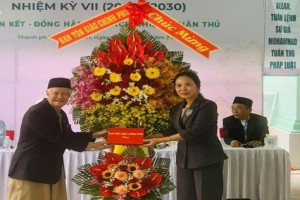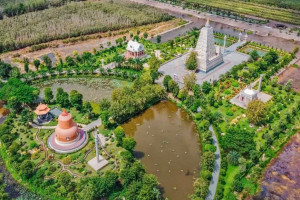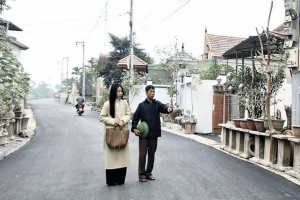
Spring is the season of festivals, all Vietnamese villages are filled with festival atmosphere. During these festivals, thurification is an important and indispensable ritual.
Offering or burning incense is the fine feature in cultural traditions. It is popular beliefs of the Oriental people in general and Vietnamese people in particular. Offering incense appeared very early and has become an important and indispensable ritual. It’s indispensable in the traditional festival as well as in ancestor worship of each Vietnamese family. Incense is considered as a bridge between the spiritual human existence and the spiritual realms of heaven, the gods.
The burning incense on the ancestral altar or altars of deities in temples, pagodas, sanctuaries in the soc’s day, vong’s day ( the first day and the 15th day of lunar month), worshipping day or Tet holiday is a fine feature of traditional culture . In offerings which offer ancestor and God, there are some incense sticks. The aroma of incense warms our heart. Incense sticks at this time are not longer normal objects, they become a spiritual and indispensable object in every family of Vietnam. Along with the other traditional customs, incense sticks have contributed to establish and preserve the identity and cultural values of Vietnamese people. On significance, burning incense shows the desire that human beings can contact with deities. In the primitive period, when people couldn’t explain the natural phenomena in the world, they deified natural phenomena and associated them with deities. Early humans being also considered deities as the Supreme Beings. They believed that deities could rule their life directly. That was why people tried to communicate with spirits. So, human beings found many ways to communicate with the Gods. No way could help people to fly. When lighting a fire, human beings gradually found that a smoke rose up. Since then, people knew how to use fire to communicate with the gods.
Human beings used incense to communicate with deities long ago and now it is difficult for us to determine when people started to use incense. We can only confirm that the form of burning incense was very early. Today, in the paintings which are discovered in the pyramids of ancient Egypt, there are images of burning. In years of CE (Christian Era),the burning of incense was popular in China, then it developed in other countries in East Asia. People have created many different kinds of incense: incense stick consists of small bamboo stick and wood powder. Wood power is covered with bamboo stick by hand; coil of incense has not a core and its shape is core. Pieces of incense are often made of aromatic wood. According to popular perception, people often burn odd number sticks (1, 3, 5, 7, 9) . Odd number represents prosperity. And the odd numbers (3, 5, 7, 9) are also significant figures in conception and in the lives of the Oriental people. When incense stick is burned, it manifests a spiritual desire and passes the prayers of people to deities. So Vietnamese people will be very anxious when they to go to temples or pagodas without incense sticks and lamps. However, in the way of offering incense, they focus on ways how to express their wish. When offering incense everybody has respectful behavior. Vietnamese people avoid to burn bundle of incense and place it on the altar, because incense smoke make everybody stuff. People always respectfully place incense sticks on the altar by both 2 hands. Incense sticks are placed straight. They manifest honesty of people. The masters of rites in villages as well as in families are virtuous men. While offering incense must show his deep respect to deities and ancestors. The selection of man who undertakes offering incense is careful. If this selection is careless, deities will punish villagers And it is an honor for a man who is carrying offering incense in rituals of village. In many Vietnamese villages, people still remain the custom of burning incense in the old trees or the corner of house. Because they think that people burn incense to ask deities’ help and supporting. Burning incense in the place is as solemn as in temples, shrines and pagodas. In religion and in popular belief, the offering incense is an important ritual and almost of religions have thurification with different forms. For Buddhism, offering incense and prayer are realized firstly in rites. In Buddhism, typical material offerings involve simple object such as: flowers, a candle or oil lamp, incense, food, water or drink. According to Buddhist conception, sincerity is expressed through incense sticks, light, fresh flowers, good fruits. Buddha is not on the altar or in the statues, but in the heart. Because of the concept “Buddha is the heart”, Buddhism dignifies sincerity of believers. Offering incense sticks to Buddha expresses sincere heart of believers. It is considered as Tam huong ( incense of mind). Anyone who reaches Tam hương can practice the Dharma and release off sufferings. So there are 5 types of Tam huong: Giới hương ( keeping the commandments);
Đinh Hương ( Zen mind); Tue Huong ( lucid wisdom); Giải Thoát Hương ( toknow how to escape from suffering by oneself); Tri Kiến Hương ( to reachenlightenment)
In the important rituals of Buddhism, thurification is highly regarded and it has a special role. Offering incense not only helps human beings in contact with deities but also manifests merciful hearts of Buddhist believers. Not only Buddhism, but also other religions such as Christianity also burn incense in its holidays. Christians burn incense before the Bible, the Blessed Sacrament three times. In ancient times, frankincense had valuable than both gold and jewels. Christians believed that the aromatic species of plants were given by the deities and they were penetrated the fragrance of deities. Hindu believers burn incense when they relax and practice meditation. According to the Confucianism, incense smoke symbolizes honorable men because it only flies off.
The rituals of some native religions in Vietnam such as Hoa Hao Buddhism, Buu Son Ky are very simple. Hoa Hao Buddhists worships Buddha through symbols “brown cloth” (the symbol of Buddha is a red cloth). Offerings to Buddha are incense sticks, flowers and water. According to Hoa Hao Buddhism, on the ancestral altar and altar in outdoor there are above offerings. Simple offerings and solemn ritual are enough to show the great spiritual values and faith in dharma
Through space and time, offering incense to gods, ancestors on the occasion of festival, New Year has been handed down from generation to generation.
Burning incense sticks can convey cultural and moral values and traditional customs. Incense sticks have contributed to establishment and preservation of values of Vietnamese cultural identity.
Phuc Nguyen




